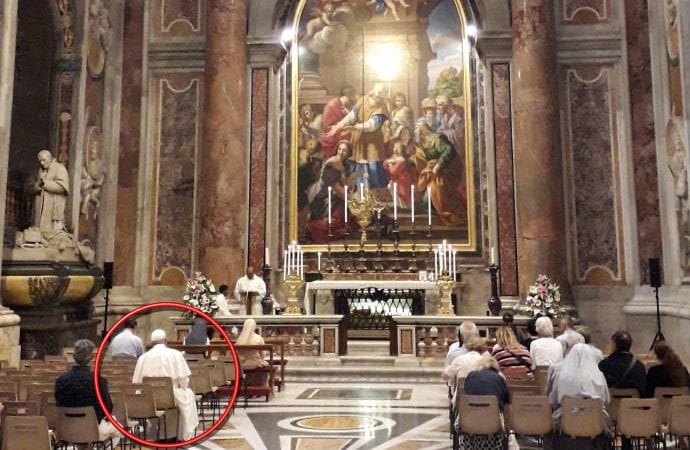This Wednesday happened to be the feast of St. Pius X, who served as pope from 1903 to 1914 and whose primary claim to fame was unleashing an “anti-modernist” purge in the Catholic Church, the targets of which were a loosely defined network of Biblical scholars, theologians and others trying, in various ways, to reconcile the faith with science and modern thought.
Pius X issued an encyclical in 1907, Pascendi Dominici Gregis, which was more or less the charter document of the campaign, describing “modernism” as “the synthesis of all heresies.” He also imposed an “anti-modernist oath” on all clergy that lasted until 1967.
Here’s what makes this interesting: If you run a Google search using the keywords “Pope Francis” and “modernism,” you’ll get more than a half-million results, most of them accusing Francis of being a modernist himself.
Yet there he was on Aug. 21, attending a Mass for the feast in a side chapel in St. Peter’s Basilica like an ordinary member of the faithful, sitting unobtrusively in the sixth row. While we have no idea what was in Francis’s mind at that moment, it’s hard not to think he wanted to honor the memory of his predecessor - suggesting, among other things, that perhaps Francis’s view of “modernism” and the Church’s efforts to resist it are a bit more nuanced than is often appreciated.
Francis’s surprise drop-in didn’t make headlines - in part, of course, because it came on the same day an Australian court announced its ruling on Cardinal George Pell’s appeal of his conviction on child sex abuse charges, rejecting that appeal in a 2-1 split decision.
In part, however, Francis’s apparent sympathy for the “anti-modernist pope” likely also didn’t have much traction because it confounds the media narrative that’s been created around Francis from the beginning. He’s supposed to be the progressive-minded Third World maverick, shaking up a fussy and hidebound institution, so it just didn’t compute.
Had Francis shown up unannounced at a memorial for Alfred Loisy, the French Biblical scholar who was often credited as the leading modernist of his day and who was excommunicated in 1908, that probably would have had an echo, because it’s what most media observers would expect. To see this pope memorialize the man who hounded Loisy out of the church, however, generates cognitive dissonance.
What all this brings to mind is the power of narrative in shaping how any public figure, a pope very much included, is understood.
In his time, Pope emeritus Benedict XVI also had a very strong narrative, and, in media terms, a highly negative one. He was seen as an archconservative, aloof, cold, and imperious, sort of the Darth Vader of organized religion. Francis, by way of contrast, has long been a media darling and still draws largely positive coverage, in part because once media organizations have made up their minds about something, they can be remarkably resistant to reconsidering it.
In the abstract, one might think that because the media scorned Benedict and embraces Francis, that ought to make a big difference in how the two popes have been received. Ironically, however, one could argue that it’s actually had the exact same effect for both, which is to render them “controversial.”
Generally speaking, reporters cover every story like a politics story. It doesn’t matter whether the subject is finance, culture, entertainment, sports or even religion - we inevitably think in terms of parties, power struggles and winners and losers, and that’s how we frame the stories we tell. (To put the point in more literary fashion, Niccolò Machiavelli is alive and well and working at every newspaper and TV news desk in the world.)
In that sense, it really doesn’t matter whether the media likes a public figure or not. By making a figure seem political, the media inevitably sets that person up to be loved by some and loathed by others.
What media attention often seems to do, in fact, is to channel the pre-existing hopes and frustrations of a broad public at specific targets, simultaneously transforming those targets into both heroes and scapegoats depending on who’s looking. (Here the appropriate literary reference is probably to René Girard, but that’s for another time.)
The negative narrative around Benedict had the perverse effect of making him wildly popular among certain Catholics, especially those most inclined to spurn the values of what they see as the modern secular liberalism the media represents. Likewise, the positive narrative around Francis has helped make him deeply unpopular in some quarters of the Church - often, though not always, the very same people who lionize Benedict.
What gets lost in the shuffle, most of the time, is the complexity of things.
In all honesty, Francis’s papacy may be closer in spirit to that of St. Paul VI than either St. John Paul II or Benedict XVI, but that hardly puts him on the far left of the Church. Benedict, meanwhile, never was the Blue Meanie of popular imagination, and certainly didn’t revive any anti-modernist putsch in the eight years he was in charge.
In other words, when the media makes someone a star, they usually also make that person a one-dimensional cardboard cutout of themselves. Nothing to be done about that, really - except, perhaps, once in a while, to allow oneself to be surprised.

